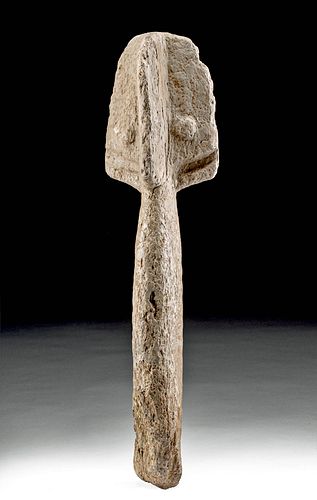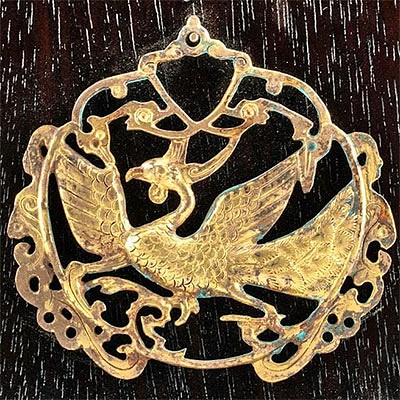African Bura Asinda Sikka Stone Anthropomorphic Idol
Lot 268
About Seller
Artemis Gallery
686 S Taylor Ave, Ste 106
Louisville, CO 80027
United States
Selling antiquities, ancient and ethnographic art online since 1993, Artemis Gallery specializes in Classical Antiquities (Egyptian, Greek, Roman, Near Eastern), Asian, Pre-Columbian, African / Tribal / Oceanographic art. Our extensive inventory includes pottery, stone, metal, wood, glass and textil...Read more
Estimate:
$1,000 - $1,500
Absentee vs Live bid
Two ways to bid:
- Leave a max absentee bid and the platform will bid on your behalf up to your maximum bid during the live auction.
- Bid live during the auction and your bids will be submitted real-time to the auctioneer.
Bid Increments
| Price | Bid Increment |
|---|---|
| $0 | $25 |
| $300 | $50 |
| $1,000 | $100 |
| $2,000 | $250 |
| $5,000 | $500 |
| $10,000 | $1,000 |
| $20,000 | $2,500 |
| $50,000 | $5,000 |
| $100,000 | $10,000 |
| $200,000 | $20,000 |
About Auction
By Artemis Gallery
Jun 17, 2021
Set Reminder
2021-06-17 10:00:00
2021-06-17 10:00:00
America/New_York
Bidsquare
Bidsquare : Ancient & Ethnographic Art Through The Ages
https://www.bidsquare.com/auctions/artemis-gallery/ancient-ethnographic-art-through-the-ages-7094
Ancient art from Egypt, Greece, Italy and the Near East, as well as Asian, Fossils, Pre-Columbian, Native American, African / Tribal / Oceanic, Fine art, and much more! All categories, all price ranges... all legally acquired and guaranteed to be as described or your money back. Artemis Gallery info@artemisgallery.com
Ancient art from Egypt, Greece, Italy and the Near East, as well as Asian, Fossils, Pre-Columbian, Native American, African / Tribal / Oceanic, Fine art, and much more! All categories, all price ranges... all legally acquired and guaranteed to be as described or your money back. Artemis Gallery info@artemisgallery.com
- Lot Description
West Africa, present day Niger and Burkina Faso, Bura-Asinda-Sikka area, ca. 1100 to 1500 CE. A hand-carved sandstone funerary idol with a columnar body, wide lateral projections, and a tall spade-form head. The highly-stylized visage is composed of annular eyes, a high-crested nose which runs from the top of the head to the neck, and an incised mouth, curved to a slight smile and split in half by the nose. Naturally embellished in warm hues of tan and beige, this fascinating figure was found in a necropolis that was filled with anthropomorphic and zoomorphic terracotta and stone figurines, frequently placed above inhumation-style burials; many of these burials also included bronze jewelry, iron weapons, and glass beads (the latter indicating that this culture had trade ties across the Sahara with North Africa). This object's pointed base would have served as a topper for an urn or as a stake for it to be placed in the ground as a gravemarker. Scholars posit that figures like this one were intended to represent individuals. Size: 4.875" W x 19.5" H (12.4 cm x 49.5 cm)
Provenance: private Houston, Texas, USA collection, acquired in 2017; ex-Gallery Jatad, Houston, Texas, USA
All items legal to buy/sell under U.S. Statute covering cultural patrimony Code 2600, CHAPTER 14, and are guaranteed to be as described or your money back.
A Certificate of Authenticity will accompany all winning bids.
We ship worldwide and handle all shipping in-house for your convenience.
#162789Nose has been reattached with restoration over break line. Expected surface wear with nicks/chips and abrasions throughout, commensurate with age. Otherwise, very nice with lovely earthen deposits.Condition
- Shipping Info
-
All shipping is handled in-house for your convenience. Your invoice from Artemis Gallery will include shipping calculation instructions. If in doubt, please inquire BEFORE bidding for estimated shipping costs for individual items.
-
- Buyer's Premium



 EUR
EUR CAD
CAD AUD
AUD GBP
GBP MXN
MXN HKD
HKD CNY
CNY MYR
MYR SEK
SEK SGD
SGD CHF
CHF THB
THB













